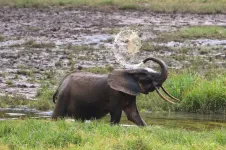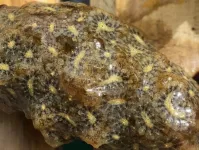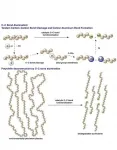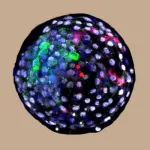INFORMATION:
WCS (Wildlife Conservation Society)
MISSION: WCS saves wildlife and wild places worldwide through science, conservation action, education, and inspiring people to value nature. To achieve our mission, WCS, based at the Bronx Zoo, harnesses the power of its Global Conservation Program in nearly 60 nations and in all the world's oceans and its five wildlife parks in New York City, visited by 4 million people annually. WCS combines its expertise in the field, zoos, and aquarium to achieve its conservation mission. Visit: newsroom.wcs.org Follow: @WCSNewsroom. For more information: 347-840-1242.
Forest elephants are now critically endangered -- here's how to count them
Study compared different methodologies using dung, DNA analysis, and camera traps
2021-04-15
(Press-News.org) LIBREVILLE, Gabon (April 15 2021) - A team of scientists led by the Wildlife Conservation Society (WCS) and working closely with experts from the Agence Nationale des Parcs Nationaux du Gabon (ANPN) compared methodologies to count African forest elephants (Loxodonta cyclotis), which were recently acknowledged by IUCN as a separate, Critically Endangered species from African savannah elephants. The study is part of a larger initiative in partnership with Vulcan Inc. to provide the first nationwide census in Gabon for more than 30 years. The results of the census are expected later this year.
Contrary to savannah elephants (Loxodonta africana) which can be counted directly, usually through aerial survey, accurately censusing elusive forest elephants is more challenging and refinements of methods were needed. Publishing a new survey method to counting forest elephants in the journal Global Ecology and Conservation, the team compared traditional methodologies to count elephant dung piles along line transects, with spatial capture-recapture (SCR) techniques using both camera traps and DNA dung analysis. SCR estimates populations by measuring how many times and in what location individual animals are recounted.
Said the study's lead author, Alice Laguardia of WCS's Gabon Program: "The more accurately we can count forest elephants, the more we can measure whether conservation efforts are successful. We are hopeful that the results of this study will help governments and conservation partners protect this Critically Endangered species throughout its range."
Researchers assessed the performance of the methodologies to three relatively large forest elephant populations in Gabon. They found that the SCR method that used DNA sampling of dung was comparable in accuracy to the line transect method but less expensive on larger scales.
Stephanie Bourgeois, coauthor and geneticist at ANPN, said: "Testing of this new DNA approach has been made possible by the recent development of novel genetics techniques by ANPN and the creation of a new genetics lab in Gabon enabling to perform all DNA analyses in-country."
SCR Camera trap surveys were more precise on smaller scales but more expensive. The authors recommend that the use of both SCR methods, and their development, continue. They say that future findings and improvements should be compiled across studies to ensure their robust evolution as an option for monitoring the African forest elephant across its range and inform strategies and action for its conservation.
Forest elephants have been decimated by ivory poachers in recent years. A WCS-led census released in 2014 documented a 65 percent decline in forest elephant numbers between 2002 and 2013. Through this new study, researchers will gain a better understanding of how many forest elephants remain and where they reside. Efforts have been focused on Gabon as it is thought to harbor more than 50 percent of the remaining forest elephant population, despite accounting for less than 15 percent of the species' range, making Gabon the most important country for forest elephant conservation.
"As long as ivory is a precious commodity, elephants will be at risk," said Lee White, the Gabonese Minister of Water, Forests, the Seas, the Environment, charged with Climate Change & Land Use Planning. "In Africa there is a clear link between environmental governance, peace and security. Countries that have lost their elephant populations have all too often descended into civil strife. Through the results of this study we hope to obtain a clear picture of the trend of poaching and elephant populations in all of Gabon."
"Vulcan recognizes the significant role of accurate population data for conservation management and policy decisions," said Ted Schmitt, director, conservation at Vulcan Inc. "By providing timely census data, we can fill critical knowledge gaps and enable prioritization of conservation resources. We are pleased to be part of this effort with Wildlife Conservation Society and the government of Gabon to help preserve this important species."
Funding for this critical work was provided by Vulcan Inc., a Seattle company founded by the late philanthropist Paul G. Allen and his sister Jody Allen, who currently serves as chair.
ELSE PRESS RELEASES FROM THIS DATE:
Epidemic of firearm injury spurs new wave of research
2021-04-15
Fifty-five years ago, America's death toll from automobile crashes was sky-high. Nearly 50,000 people died every year from motor vehicle crashes, at a time when the nation's population was much smaller than today.
But with help from data generated by legions of researchers, the country's policymakers and industry made changes that brought the number killed and injured down dramatically.
Research led to changes in everything from road construction and driver's license rules, to hospital trauma care, to laws and social norms about wearing seatbelts and driving while drunk or using a cell phone.
Now, researchers at the University ...
Long-term survival rates for immunotherapies could be misinterpreted
2021-04-15
Immune checkpoint inhibitors have transformed cancer care to the point where the popular Cox proportional-hazards model provides misleading estimates of the treatment effect, according to a new study published April 15 in JAMA Oncology.
The study, "Development and Evaluation of a Method to Correct Misinterpretation of Clinical Trial Results With Long-term Survival," suggests that some of the published survival data for these immunotherapies should be re-analyzed for potential misinterpretation.
The study's senior author, Yu Shyr, PhD, the Harold L. Moses Chair ...
Environmental protection could benefit from 'micro' as well as 'macro' thinking
2021-04-15
Scientists at the University of Southampton have conducted a study that highlights the importance of studying a full range of organisms when measuring the impact of environmental change - from tiny bacteria, to mighty whales.
Researchers at the University's School of Ocean and Earth Science, working with colleagues at the universities of Bangor, Sydney and Johannesburg and the UK's National Oceanography Centre, undertook a survey of marine animals, protists (single cellular organisms) and bacteria along the coastline of South Africa.
Lead researcher and postgraduate student ...
Physicists develop theoretical model for neural activity of mouse brain
2021-04-15
The dynamics of the neural activity of a mouse brain behave in a peculiar, unexpected way that can be theoretically modeled without any fine tuning, suggests a new paper by physicists at Emory University. Physical Review Letters published the research, which adds to the evidence that theoretical physics frameworks may aid in the understanding of large-scale brain activity.
"Our theoretical model agrees with previous experimental work on the brains of mice to a few percent accuracy -- a degree which is highly unusual for living systems," says Ilya Nemenman, Emory professor of physics and biology and senior author of the paper.
The ...
Plastics could see a second life as biodegradable surfactants
2021-04-15
Scientists at the Institute for Cooperative Upcycling of Plastics (iCOUP), an Energy Frontier Research Center led by Ames Laboratory, have discovered a chemical process that provides biodegradable, valuable chemicals, which are used as surfactants and detergents in a range of applications, from discarded plastics. The process has the potential to create more sustainable and economically favorable lifecycles for plastics.
The researchers targeted their work on the deconstruction of polyolefins, which represents more than half of all discarded plastics, and includes nearly every kind of product imaginable-- toys, food packaging, pipe systems, water ...
Investigating heavy quark physics with the LHCb experiment
2021-04-15
A new review published in EPJ H by Clara Matteuzzi, Research Director at the National Institute for Nuclear Physics (INFN) and former tenured professor at the University of Milan, and her colleagues, examines almost three decades of the LHCb experiment - from its conception to operation at the Large Hadron Collider (LHC) - documenting its achievements and future potential.
The LCHb experiment was originally conceived to understand the symmetry between matter and antimatter and where this symmetry is broken - known as charge conjugation parity (CP) violation. Whilst this may seem like quite an obscure area of study, it addresses one of the Universe's most fundamental questions: how it came to be dominated ...
Tracking the progress of fusion power through 60 years of neutral particle analysis
2021-04-15
As the world's energy demands grow, so too does growing concern over the environmental impact of power production. The need for a safe, clean, and reliable energy source has never been clearer. Fusion power could fulfil such a need. A review paper published in EPJ H examines the 6-decade history of neutral particle analysis (NPA), developed in Ioffe Institute, Saint Petersburg, Russia, a vital diagnostic tool used in magnetic plasma confinement devices such as tokamaks that will house the nuclear fusion process and generate the clean energy of the future.
As ...
Researchers generate human-monkey chimeric embryos
2021-04-15
Investigators in China and the United States have injected human stem cells into primate embryos and were able to grow chimeric embryos for a significant period of time--up to 20 days. The research, despite its ethical concerns, has the potential to provide new insights into developmental biology and evolution. It also has implications for developing new models of human biology and disease. The work appears April 15 in the journal Cell.
"As we are unable to conduct certain types of experiments in humans, it is essential that we have better models to more accurately study and understand human biology and disease," says senior author Juan Carlos Izpisua Belmonte, a professor in the Gene Expression ...
Chimeric tool advanced for wide range of regenerative medicine, biomedical research applications
2021-04-15
LA JOLLA--(April 15, 2021) The ability to grow the cells of one species within an organism of a different species offers scientists a powerful tool for research and medicine. It's an approach that could advance our understanding of early human development, disease onset and progression and aging; provide innovative platforms for drug evaluation; and address the critical need for transplantable organs. Yet developing such capabilities has been a formidable challenge.
Researchers led by Salk Professor Juan Carlos Izpisua Belmonte have now come one step closer toward this goal by demonstrating a new integration of human cells into animal tissue. Published in the journal Cell on April 15, 2021, the new study builds upon previous work by the Izpisua Belmonte lab to take the next step in chimeric ...
Water scarcity footprint reveals impacts of individual dietary choices in US
2021-04-15
Illustration
A lot of attention has been paid in recent years to the carbon footprint of the foods we eat, with much of the focus on the outsize contribution of meat production and especially beef.
But much less is known about the implications of individual U.S. dietary choices on other environmental concerns, such as water scarcity.
In a study scheduled for online publication April 15 in the journal Nature Food, researchers from the University of Michigan and Tulane University present a water scarcity footprint that measures the water-use impacts of U.S. diets, taking into ...
LAST 30 PRESS RELEASES:
Simple method can enable early detection and prevention of chronic kidney disease
S-species-stimulated deep reconstruction of ultra-homogeneous CuS nanosheets for efficient HMF electrooxidation
Mechanical and corrosion behavior of additively manufactured NiTi shape memory alloys
New discovery rewrites the rules of antigen presentation
Researchers achieve chain-length control of fatty acid biosynthesis in yeast
Water interactions in molecular sieve catalysis: Framework evolution and reaction modulation
Shark biology breakthrough: Study tracks tiger sharks to Maui mating hub
Mysterious iron ‘bar’ discovered in famous nebula
World-first tool reduces harmful engagement with AI-generated explicit images
Learning about public consensus on climate change does little to boost people’s support for action, study shows
Sylvester Cancer Tip Sheet for January 2026
The Global Ocean Ship-Based Hydrographic Investigations Program (GO-SHIP) receives the Ocean Observing Team Award
Elva Escobar Briones selected for The Oceanography Society Mentoring Award
Why a life-threatening sedative is being prescribed more often for seniors
Findings suggest that certain medications for Type 2 diabetes reduce risk of dementia
UC Riverside scientists win 2025 Buchalter Cosmology Prize
SETI Institute opens call for nominations for the 2026 Tarter Award
Novel theranostic model shows curative potential for gastric and pancreatic tumors
How beige fat keeps blood pressure in check
Fossils reveal ‘latitudinal traps’ that increased extinction risk for marine species
Review: The opportunities and risks of AI in mental health research and care
New map reveals features of Antarctic’s ice-covered landscape
Beige fat promotes healthy vascular function and blood pressure in mice
Chronic low-dose pesticide exposure reduces the life span of wild lake fish, China-based study shows
Tiny earthquakes reveal hidden faults under Northern California
Long-term pesticide exposure accelerates aging and shortens lifespan in fish
Professor Tae-Woo Lee's research group develops groundbreaking perovskite display technology demonstrating the highest efficiency and industry-level operational lifetime
The “broker” family helps tidy up the cell
Ecology: Mummified cheetahs discovery gives hope for species’ Arabic reintroduction
Researchers survey the ADHD coaching boom
[Press-News.org] Forest elephants are now critically endangered -- here's how to count themStudy compared different methodologies using dung, DNA analysis, and camera traps




